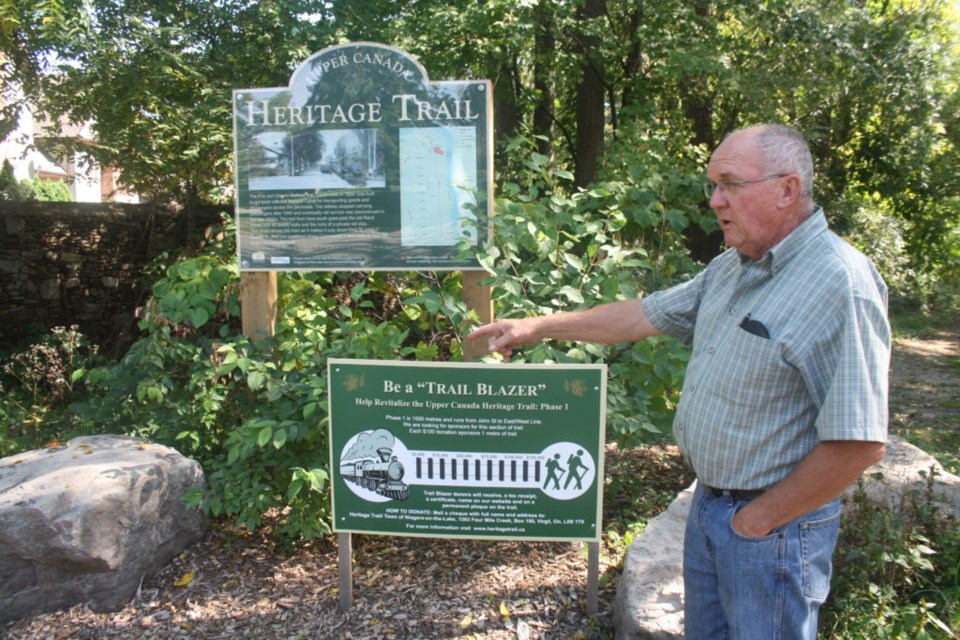
Rick Meloen is hoping his enthusiasm for the preservation of the Upper Canada Heritage Trail is contagious.
When the former Town roads supervisor retired in 2009, he developed an intense interest in the history of his hometown.
Since then, he has popped up in many roles. He has a small farm on Hunter Road, yet still finds time to give back to the community in many ways. He was very active in plans to commemorate the War of 1812. He’s well-known as an organizer of the Niagara Parkway’s tiny chapel Easter sunrise service. He was instrumental in planning the Town’s Canada 150 celebrations, and he continues to volunteer with the Niagara-on-the-Lake Historical Society & Museum and the Friends of Fort George.
His focus these days came about as part of a legacy project of the 150th commemoration events — the preservation and restoration of the heritage trail.
As chair of the committee overseeing that work, he plans to lead two three-kilometre tours along a portion of the trail, taking the opportunity to talk about its history and the effects to restore and preserve it.
The trail follows an old railway line, and it’s the history of the railroad and its impact on the town Meloen wants to talk about.
“It’s interesting to note where the train used to go, and to have the vision of what this trail used to look like. It was very different from what it looks like now,” he says.
The Upper Canada Heritage Trail was established in 1854 as part of the first steam-powered Erie & Ontario Railway linking Niagara-on-the-Lake with Niagara Falls, and the Great Western Railway.
The railroad brought life to the town following the War of 1812, and attracted tourism and commerce.
Rail operations ceased in the mid-1950s, but the trail continues to provide a connection from the southern Niagara Escarpment to the Niagara Commons.
Tours take place Oct. 3 and 4, beginning at 5 p.m. at the entrance to the trail at the corner of John Street and King Street.
The tour will follow 1.5 kilometres of the trail, crossing Charlotte Street to East and West Line, and then heading back for a three-kilometre walk in total, says Meloen.
Organized in conjunction with the museum, the tours are “an extension of the neighbourhood walks,” he says.
On a warm afternoon last week, Meloen walked part of the trail to point out some of the restoration work he hopes to see. The combination of dirt and grass makes for a good walk when it’s dry, but not after a heavy rain.
“You can imagine what it looks like during the spring, or in inclement weather,” he says.
The plan is for a crushed stone surface, that will retain a natural look while providing a good walking path in all seasons, although it won’t be plowed in the winter, says Meloen. “We want it to be accessible most of the year.”
There are many regulars who enjoy the trail, but the goal of the tours is to encourage people who have never used it to give it a try, he said.
“We hope it will be a great experience for people to learn about the history of the railway, while enjoying the trail,” says Meloen.
He will also share some of the challenges of the restoration, which include an archaeological study required for the first phase, from John Street to East and West Line, and bringing heavy equipment onto the pathway while keeping it open for walking while it’s under construction, says Meloen.
Phase two is from East and West Line to Line 3, phase three from there to Line 9, and from there, the most challenging section is from Line 9 to York Road.
There is also the task of making people aware that when the path borders private agricultural land, they are not to trespass or help themselves to fruit, he says. Food safety and security are a concern to the agricultural community, and the trail committee is working with farmers to ensure their property is protected.
Proceeds from the tours will go toward the restoration of the trail, to make it safer and more accessible, he says.
Parking is available at the Parks Canada lot on John Street.
Tickets are $10 per person and participants are encouraged to wear running shoes, bring a water bottle and dress accordingly. Reservations are required by calling the museum at 905-468-3912.
For more information on the Upper Canada Heritage Trail and the committee’s efforts, visit https://www.heritagetrail.ca/.